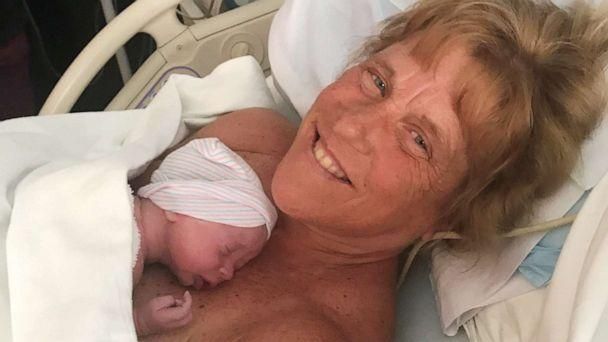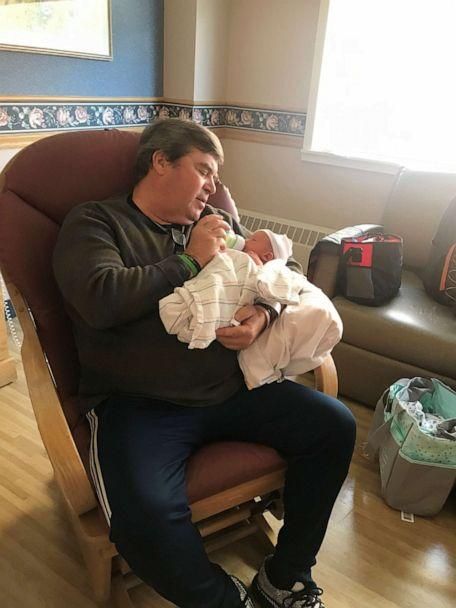Medical Experts Explain How Barbara Higgins Sustained A Pregnancy And Successful Birth At 57

“I’m mostly proud of my body. If I wasn’t healthy enough and if my body wasn’t youthful enough to grow a child, Jack wouldn’t be here right now.”
Higgins, a physical education teacher and former competitive runner, went through a long and emotional journey in order to give birth to her third child.
She and her husband, Kenny Banzhoff, 65, lost their youngest daughter, Molly, to an undiagnosed brain tumor in 2016 at the age of 13.
Shortly after Molly’s death, Higgins whose older daughter, Gracie, is now 20 said she began having dreams of having a third child. Higgins said:
“The connection between Molly’s death and Jack’s arrival are definitely there, but it was never this obvious, well, Molly has died so I need to have a baby. It was just this dream that I started having.”
Higgins was 53 at the time of Molly’s death, already past what is typically considered to be a woman’s prime childbearing years.
She continued to have the dreams of having a third child, but didn’t follow through with it until several years later, in 2018. According to Higgins:
“I thought, ‘Well, I’m going to do what it tells me. I’m going to go the doctor and have bloodwork and see where this will or won’t take me.”
SEE ALSO: Amazing Birth Story Of Mum, Melanie Bassett Who carried Her Triplets In Separate Wombs
Higgins, who said her husband was fully supportive of trying for another child, began undergoing a litany of tests — both mental and physical — to see if she could sustain a pregnancy and give birth in her 50s.
“It was not a quick process and that was also reassuring to us,” she said. “Everything that went well made us think, okay, this is a decision that could work.”
A former track star at Boston University and current CrossFit athlete, Higgins saw her years of living a healthy lifestyle pay off during the testing process.
“She’s functionally like someone who is in her 30s, in my opinion,” said her OBGYN, Dr. Ashish Chaudhari, of Dartmouth-Hitchcock Concord. “It’s a testament to how healthy she was in keeping her body in tip-top shape.”
Through the rigorous testing required by her doctors, Higgins ran into one obstacle that ultimately saved her life. An MRI led doctors to discover that Higgins had three brain tumors, which she was able to have successfully removed.
“I never would have found those tumors if I wasn’t trying to have a child, so I look at Jack sometimes as my little lifesaver,”
she said.

How Higgins sustained a pregnancy and successful birth at 57
When Higgins became pregnant with Jack last year at age 56, she was more than two decades past the age — 35 — that medics consider women to be of “advanced maternal age.”
She found help in her journey from Dr. Vito Cardone, a reproductive endocrinology and infertility specialist in Stoneham, Massachusetts. Cardone said:
“Unfortunately a lot of centers have age limits on who they will help for fertility. In my opinion, you need to look at each individual as an individual.”
“You can see that she is the type of woman that trains and is in a great shape, much better than many people I work with who are 25 or 30 years old,”
Cardone said of Higgins. “And she knows what she’s getting into and [knows] that she really desires a child.”
“It’s not everybody at age 57 who I will accept for treatment.”
Higgins became pregnant with Jack through in-vitro fertilization (IVF), but declined to share further details. Higgins said:
“It’s a tender piece. We researched all the different ways and chose the way that worked best for us. That’s going to stay between Kenny and myself.”
“At my age, I find that the more I share the more people criticize and I wouldn’t want my experience to scare someone else from taking steps to having a baby in their 50s,”
she added.
Giving birth later in life is a growing reality in the United States. Since 2007, the birth rate has risen 19% for women in their early 40s, 11% for women in their late 30s and just 2% for women in their early 30s. Birth rates for women in their 20s declined from 2015 to 2016, according to the Centers for Disease Control and Prevention (CDC).
“We need to change our views on what age is okay to get pregnant, that’s how I look at it,” said Cardone.
“When I started 40 years ago, I wasn’t helping a lot of women that were over the age of 45 and then with time, with improvements, we’ve gotten to a more advanced age.”
Cardone said he looks not only at a woman’s physical and mental health, but also at what the current life expectancy is for women in the United States. He said:
“I want the child to be with the parent of at least 20 or 30 years. The life expectancy charts are saying now that 80 or 85 is the age of a woman’s life expectancy.”
Higgins said that while women in her family have lived well into their 90s, she focused on on another factor when deciding whether to have a child in her 50s. She said:
“I [thought] to myself, ‘No one really knows what’s going to happen to them.'”I lost a child. I did not wake up on May 1, 2016, and think Molly would die, and she did.”
Higgins said she also considered how much more wisdom and free time she and her husband, who is retired, have now versus when they were raising their daughters in their late 30s and 40s.
“In a typical life, you get married, buy a house, start a job and have a kid all in like a five-year period,” said Higgins. “Now, at our age, we’ve done all of those things.”
“We decided it should be party in your 20s, marry in your 30s , career in your 40s and then retire and have babies in your 50s.”
That same mentality helped Higgins throughout her pregnancy, during which she said she appreciated every moment. Higgins said:
“When you’re in your 30s, everything is a disruption. This time around, it was like memorable as opposed to uncomfortable or painful. I didn’t once mind the changes in my body.”
Higgins’ body, due to her healthy diet and exercise, was conditioned well enough to endure the stress of a pregnancy, according to Cardone. He said:
“Pregnancy is a stress on the body and it’s not just the uterus and the placenta and the baby. The heart, the kidney, the lungs, all of these have to work harder in order to be able to sustain and grow and delivery the pregnancy.”
Higgins also underwent more frequent than usual ultrasounds and testing throughout her pregnancy, according to her OBGYN, Dr. Chaudhari. He said:
“She was coming in twice a week to have heart rate testing on the baby. She passed all those tests wonderfully.”
Higgins gave birth to Jack on March 20, 36 weeks and five days into her pregnancy. Jack was born quickly and at a healthy 5 pounds, 13 ounces, according to Higgins.
“I had a cup of coffee, had a baby and had lunch,” she said. “It was my quickest labor ever.”
Jack and Higgins are both home now, and Higgins said she and Banzhoff are adjusting well to life as new parents in their 50s and 60s, respectively.
“There’s a reason he’s here,” she said of Jack.
“Maybe he’s going to be the best ever little league coach or maybe he’s going to be a custodian at a a school and look out for kids who get bullied or maybe he’s going to be a rocket scientist and invent some amazing thing that saves the planet.
“His life will bring him there. I’ll be there to watch it for as long as I can,”
Higgins said.



